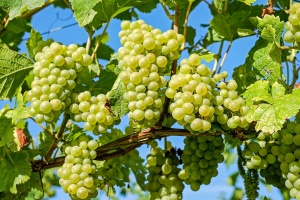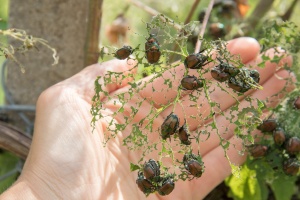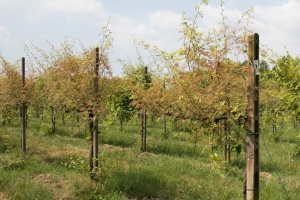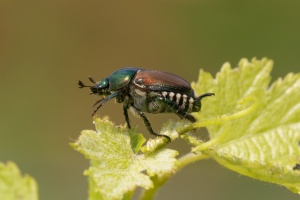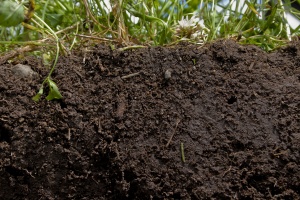Super User
First detection of the Japanese Beetle on Azores (Terceira Island)
The Japanese beetle, Popillia japonica Newman, was introduced on Terceira Island (Azores) early in the 1970s. The combination of mild temperatures, high relative humidity, and a lot of rain created the perfect conditions for the establishment and rapid spread of the beetle, which, despite initial control efforts, quickly spread to the island's interior agricultural regions and posed a threat to the local plants and horticultural lands.
Since 1974 adult populations have been monitored using pheromone and floral lure traps distributed across the entire island. The data revealed a distribution pattern across three circular zones with decreasing population densities and a movement of the infestation's central core to the island's interior to more conducive zones for the beetle's development. In 1989, 15 years after the discovery of the first insects on the island, the pest had taken over all the available space. Currently, eight of the nine islands of the Archipelago are infested.
A contingency plan was drawn up with a view to establishing protective measures to prevent the spread of the Popillia japonica to Madeira and Portugal mainland in 1985 (Decreto Legislativo Regional 11/85/A, de 23 de Agosto). Later, it was actualized to comply with the legislation of the European Union (EU), paying particular attention to the categorization of this insect as a priority pest.
P. japonica completes its life cycle on Terceira Island in a single year, with individuals starting to emerge from the ground at the end of May and reaching their peak densities in early August. With the last beetles being seen as late as the end of October. The first and second larval instars typically have a brief lifespan, and by early October, most of the population has reached the third instar. The third instar grubs stop feeding and begin pupating at the beginning of May. The pupal stage lasts for less than a month, and after late July, no pupae were seen. Adults eat the foliage, floral parts, and occasionally the fruits of various agricultural plants and ornamentals, while the grubs live off the roots of the pastures that make up most of the island. Eighteen local plant species in 8 families (Fagaceae, Platanaceae, Poaceae, Polypodiaceae, Rosaceae, Salicaceae, Ulmaceae, and Vitaceae) may suffer extensive damage from adult beetles.
References:
Martins, A. & N. Simões. 1985. Population Dynamics of the Japanese beetle (Coleoptera, Scarabaeidae) in Terceira Island – Azores. Arquipélago, Sér. C. N. 6, 57-62.
Simões, N. & A. Martins. 1985. Life Cycle of Popillia japonica Newman (Coleoptera, Scarabaeidae) in Terceira Island – Azores. Arquipélago, Sér. C. N. 6: 173-179.
Martins, A., Paiva, M. R., & Simões, N. (1988). Japanese Beetle: Monitoring in the Azores with Semiochemicals. Ecological Bulletins, 39, 101–103.
Martins, A., (1996). The Japanese beetle on Terceira Island (Açores) and the influence of soil physical factors on the efficacy of the fungus Metarhizium anisopliae (Metsch.) sorokin on the larval control of the insect. PhD thesis, University of Azores.
Tools for collaboration and data exchange
Since invasive species like Popillia japonica fall under special attention on an EU-wide and international level, the need for exchanging data and sharing observations is a core element in the Citizen Science project. The IPM Popillia project gathers observational data with the help of citizens like farmers, gardeners, or the interested public. IPM Popillia is designed to be a project open for collaborations. We already offer options for an automated data exchange in external partnerships via API or RSS Endpoints. To extend the feasibility and scope of the project in the future, our development team of the SPOTTERON Citizen Science App platform is looking forward to working together with stakeholders and institutions to further expand on data sharing and notification possibilities.
Available connectors in the IPM Popillia project
API
An "application programming interface" or API is a connection between computer programs, allowing the direct exchange of data or integrating one service into another. For IPM Popilla, we can provide access to the Citizen Science App's API for external project partners to automatically fetch user-generated data points and their attributes, images, and GEO locations. External project partners can use the API to populate their databases with Citizen Science observations, apply filters, and develop custom applications connected to the IPM Popillia's public user-generated data. Along with the technical API access, we provide up-to-date API documentation for such partners, containing all variables, IDs, and example endpoints.
RSS Feed
We have developed an RSS Endpoint for an easy-to-use transfer option of the latest contributions in the Citizen Science App. An RSS Feed endpoint allows RSS Readers to fetch chronological data from the Citizen Science App and even connect the data to services like "If This Then That" (IFTT) for automation and data conversion. With access to the RSS Feed, new observations can automatically be imported into desktop apps and be used to review ongoingly incoming records from the App.
Possible future development: Automated systems for notifications based on in-App parameters
Due to the sensitive nature of Popillia japonica sightings (or of other high alert invasive species), an automated system can be a practical development in the course of the project. Such a system can utilize configurations for, e.g., only report Citizen observations, which fulfill criteria like being a confirmed classification by the Citizen Science App's community or validated by the project's admin team. Stakeholders can use automated notifications to get alerts of sightings of a critical invasive species while filtering out unsure classifications.
This advanced system can be a future development step for project-to-stakeholder collaboration.
Please get in contact if you are interested in a partnership for invasive species monitoring and data exchange on Popillia japonica citizen observations:
Contact
To get in contact with the coordinator of the project:
Agroscope
Dept. of Plant Protection
Ecological Plant Protection in arable crops
Reckenholzstrasse 191, CH - 8046 Zurich
email: This email address is being protected from spambots. You need JavaScript enabled to view it.
phone: +41 (0)58 468 7597
The activities of IPM-Popillia
The activities of IPM-Popillia will contribute to finding adequate responses to new and/or emerging plant pests/diseases. Although P. japonica appeared on the Azores already decades ago, it is a new pest to mainland Europe after the invasion of northern Italy in 2014. It has been nominated a candidate high priority pest in European Plant Health legislation. The innovative monitoring tools developed in IPM-Popillia will help to detect any natural spread or unintended transport of P. japonica from the infested zone to pest-free areas much faster than previously possible.
Popillia japonica - an invasive species coming to Europe
Sustainable agriculture and food security in Europe is threatened by invading pests in the course of trade and the movement of goods and people. Already for more than a century, the Japanese beetle (Popillia japonica) has been a major plant pest in the US. Only recently, it was introduced to Italy and continues to spread. The beetle is eager to feed on hundreds of ornamental plants, fruit trees, vegetable plants, forest trees and crop plants. The adult beetles are only active for a couple of weeks in the summer and their larvae live underground, which makes them difficult to eradicate.
About the IPM-Popillia project
The aim of IPM-Popillia is to address the challenge of a new risk to plant health in Europe, the invasion of the Japanese beetle, Popillia japonica. This pest was introduced accidentally to mainland Europe in 2014 (EPPO 2014) and can easily spread in the course of trade and the movement of goods and people. P. japonica threatens the entire agricultural sector, urban landscapes, and biodiversity in invaded areas.
Prevention of the species’ invasion faces two constraints: The possibilities to restrict the movement of goods and people are limited, and successful eradication of the population established south of the Italian-Suisse border is impossible.
Imprint
Project information
Partners in the IPM Popillia project:
Coordinator:
Agroscope
Dept. of Plant Protection
Ecological Plant Protection in arable crops
Reckenholzstrasse 191, CH - 8046 Zurich
phone: +41 (0)58 468 7597
www.agroscope.ch
Participants:
|
Participant No. |
Participant organisation name |
Country |
|
1 |
Eidgenössisches Departement für Wirtschaft, Bildung und Forschung – Agroscope (WBF-Agroscope) |
CH |
|
2 |
Università degli studi di Siena (Unisi) |
IT |
|
3 |
E-nema Gesellschaft für Biotechnologie und Biologischen Pflanzenschutz mbH (e-nema) |
DE |
|
4 |
Pessl Instruments GmbH (Pessl) |
AT |
|
5 |
Spotteron Gmbh (Spotteron) |
AT |
|
6 |
Vignaioli Piemontesi S.C.A (Vignaioli Piemontesi) |
IT |
|
7 |
Institut national de la recherche agronomique (INRA) |
FR |
|
8 |
Consiglio per la ricerca in agricoltura e l’analisi dell’economia agraria (CREA) |
IT |
|
9 |
Technische Universität München (TUM) |
DE |
|
10 |
Dipartimento dell'economia, Sezione dell'agricoltura, Servizio fitosanitario Ticino (SFTi) |
CH |
|
11 |
Regione Piemonte - Settore Fitosanitario e servizi tecnico-scientifici (Regione Piemonte) |
IT |
|
12 |
Fundação Gaspar Frutuoso (FGF) |
PT |
|
13 |
Jardin Suisse (Jardin Suisse) |
CH |


